

Gudrid, la Vikinga. Gudrid, la hija de Hallveig Einarsdottir y del terrateniente Thorbjörn Vifilsson habría nacido alrededor del 980 en una Islandia que instalaba el Cristianismo como la religión oficial.
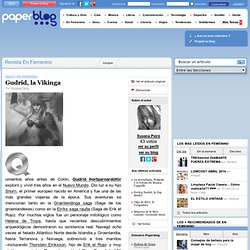
A los 19 años se casó con el comerciante Thorfinn Karlsefni, y la nueva pareja partió en su knörr rumbo a esas tierras maravillosas, que el intrépido Erik el Rojo llamaba Groenlandia (Tierra Verde) y sobre todo a la mítica Vinland (Tierra del Vino). Naufragaron frente a las costas de la gran isla y Gudrid perdió entonces un marido por primera vez. THE MAINE PENNY: A MEDIEVAL COIN FOUND IN NEW ENGLAND SOIL. Arthur Shippee forwarded this article about a "wrong place" coin - a medieval piece discovered in New England.

This piece came up in The E-Sylum before, but I couldn't find any follow-up discussion from our readers. Is anyone familiar with this piece and the controversy surrounding it? -Editor Beachcombing is pleased to introduce a more controversial wrong-place piece, an eleventh-century Viking coin that allegedly ended up in New Englands soil several generations before Columbus. The Maine Penny, as it called, was found by an amateur (an ugly word for archaeologists) at the Goddard site near the mouth of Penobscot Bay on 18 August 1956. It is universally accepted that the Goddard site was occupied by Indians in the twelfth and thirteenth centuries and many thousands of items were excavated there.
The discovery of a Viking penny in New England would be remarkable, exciting and worth playing the bagpipes over. So why the scepticism? Wayne Homren, Editor. Norse colonization of the Americas. The Norse colonization of the Americas began as early as 10th century AD, when Vikings explored and settled areas of the North Atlantic, including the northeastern fringes of North America.[1] The Norse colony in Greenland lasted for almost 500 years.

Continental North American settlements were small and did not develop into permanent colonies. While voyages, for example to get timber, are likely to have occurred for some time, there is no evidence of enduring Norse settlements on mainland North America.[2] Greenland saga. The Grœnlendinga saga ( listen ) (spelled Grænlendinga saga in modern Icelandic and translated into English as the Saga of the Greenlanders) is an Icelandic saga.
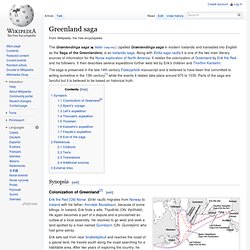
Along with Eiríks saga rauða it is one of the two main literary sources of information for the Norse exploration of North America. It relates the colonization of Greenland by Erik the Red and his followers. It then describes several expeditions further west led by Erik's children and Thorfinn Karlsefni. Skræling. Maps showing the different cultures in Greenland, Labrador, Newfoundland and the Canadian arctic islands in the years 900, 1100, 1300 and 1500.
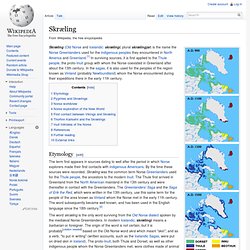
The green colour shows the Dorset Culture, blue the Thule Culture, red Norse Culture, yellow Innu and orange Beothuk Etymology[edit] The term first appears in sources dating to well after the period in which Norse explorers made their first contacts with indigenous Americans. By the time these sources were recorded, Skræling was the common term Norse Greenlanders used for the Thule people, the ancestors to the modern Inuit. Confirman que los vikingos pisaron América en el siglo X. DESCUBRIMIENTO HISTORICO: UNA EXPOSICION RECREA EN WASHINGTON LA TRAVESIA DE LEIF ERICSONConfirman que los vikingos pisaron América en el siglo X En la isla canadiense de Terranova están las ruinas de un asentamiento vikingo, que data de aquella época.

L''Anse aux Meadows, en el extremo norte de la isla de Terranova, en Canadá, es el sitio que los arqueólogos coinciden en señalar como el primer y único asentamiento vikingo auténtico en América del Norte, establecido quinientos años antes de los viajes de Colón. Y las ruinas de ocho casas y talleres en ese sitio se convertirán este año en el eje de la conmemoración de la cultura vikinga. "Este asentamiento por fin nos condujo a Vinland", señaló Birgitta Linderoth Wallace, arqueóloga de Parks Canada que estudia el lugar desde hace años.
Es cierto que eran guerreros temibles y que asolaron las costas europeas y las islas británicas, entre los años 750 y 1050. Bigfoot. Bigfoot, also known as Sasquatch, is the name given to a cryptid ape- or hominid-like creature that some people believe inhabits forests, mainly in the Pacific Northwest region of North America.
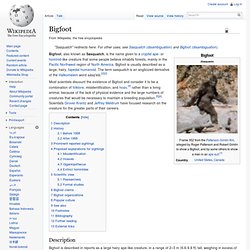
Bigfoot is usually described as a large, hairy, bipedal humanoid. The term sasquatch is an anglicized derivative of the Halkomelem word sásq'ets.[2][3] Most scientists discount the existence of Bigfoot and consider it to be a combination of folklore, misidentification, and hoax,[4] rather than a living animal, because of the lack of physical evidence and the large numbers of creatures that would be necessary to maintain a breeding population.[5][6] Scientists Grover Krantz and Jeffrey Meldrum have focused research on the creature for the greater parts of their careers. Description History Before 1958 Wildmen stories are found among the indigenous population of the Pacific Northwest.
Cultura Dorset. La cultura Dorset precedió a la cultura Inuit en el Ártico norteamericano.
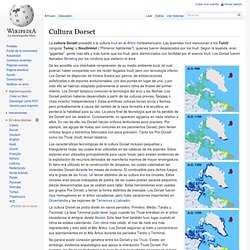
Las leyendas Inuit mencionan a los Tuniit (singular Tuniq) o Sivullirmiut ("Primeros habitantes"), quienes fueron desplazados por los Inuit. Según la leyenda, eran "gigantes", gente más alta y más fuerte que los Inuit, pero atemorizados con facilidad por el avance Inuit. Los Dorset fueron llamados Skræling por los nórdicos que visitaron el área. Se les acredita una intachable comprensión de su medio ambiente local (el cual podrían haber compartido con los recién llegados Inuit) pero con tecnología inferior. Beothuk. Situación de los beothuk.
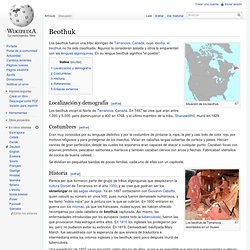
Los beothuk fueron una tribu aborigen de Terranova, Canadá, cuyo idioma, el beothuk no ha sido clasificada. Algunos la consideran aislada y otros la emparentan con las lenguas algonquinas. Saga. Sagas are stories about ancient Scandinavian and Germanic history, about early Viking voyages, the battles that took place during the voyages, about migration to Iceland and of feuds between Icelandic families.
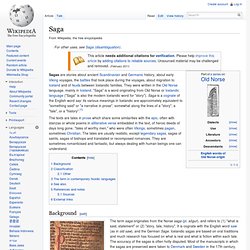
They were written in the Old Norse language, mainly in Iceland. "Saga" is a word originating from Old Norse or Icelandic language ("Saga" is also the modern Icelandic word for "story"). Saga is a cognate of the English word say: its various meanings in Icelandic are approximately equivalent to "something said" or "a narrative in prose", somewhat along the lines of a "story", a "tale", or a "history".[1] The texts are tales in prose which share some similarities with the epic, often with stanzas or whole poems in alliterative verse embedded in the text, of heroic deeds of days long gone, "tales of worthy men," who were often Vikings, sometimes pagan, sometimes Christian.
Background[edit] There are plenty of tales of kings (e.g. Classification[edit] Queen Ragnhild's dream Other[edit]